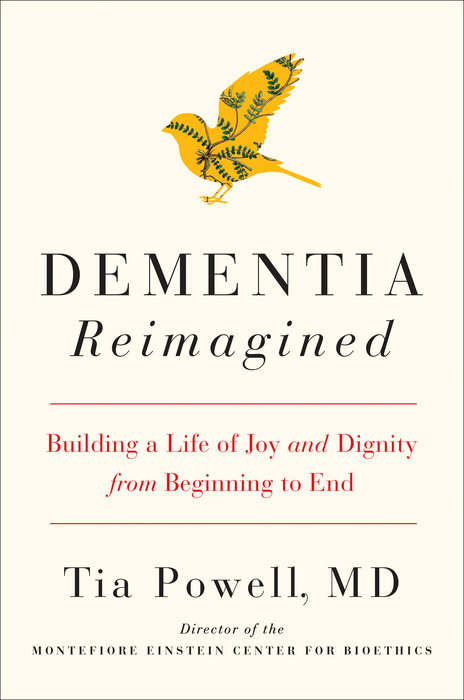
Medium – How I’m Preparing for the Dementia I Believe I’ll Get
April 12, 2019From The Hastings Center Report 48, no 5 (2018).
In writing these essays, we were asked to consider, “What makes a good life in late life?” I thought instantly, perhaps like many people, of photos and
stories of older people taking up new careers and new hobbies—running marathons and soup kitchens, starting organic farms. This response is right and proper.
Older people can leverage wisdom and creativity to make wonderful contributions to their communities and should be celebrated for doing so. But this happy picture is incomplete. We live longer than ever before,
and with that long life, many of us can expect disability. This is the product of medical success. We are less likely to die from cancer, a heart attack, or a stroke; we survive with chronic illnesses and their associated disabilities. A
good life in late life, for many of us, will be a life with disability.1
Some decline in function with age is normal, is incremental, and doesn’t rise to the level of disability (although it can still be a nuisance). For this essay, however, I focus on dementia, a common and ultimately fatal illness,
and one that typically lasts many years from the start of symptoms to the end. More than five million Americans currently suffer from dementia; fifteen million paid and volunteer caregivers help support them.2 To answer the question of what makes a good late life, we must answer it for those with dementia, for their marathon is especially daunting.
What would a good life with dementia look like? How would it change from the early phase, when cognitive impairment and other challenges are relatively modest, to the final phase marked by severe cognitive and physical decline? One expert who can help illuminate the challenges is Lonnie Schicker, who was among the most eloquent speakers at a 2017 National Institutes of
Health Summit on Dementia Care. Schicker’s expertise stems from her career in health education but also from her lived experience as a person with dementia. Here are excerpts from her comments:
“People are always at a loss for words when I tell them
that my oldest friends and some family members
have limited or no contact with me since my diagnosis,
despite my efforts to stay in contact with them
. . . . People are afraid of the diagnosis and stay away,
whether intentionally or unintentionally, because of
the uncomfortableness of it all. Those who are with
me are with me, and they no doubt will continue to be
. . . . We all know that it will only become more intense
. . . . Decline is inevitable. The obstacles are immense.
I have had intense mood swings to the point of suicidal
ideation. I fall. I get lost. I don’t understand money. I
have more health issues . . . . I have seen my loving,
devoted son cry out of frustration and anticipation of
what is to come.”3
Schicker exposes critical impediments to building a good life with dementia. She speaks clearly about her current symptoms and the knowledge that they will grow worse. But among her most serious problems is the fear that this stigmatized illness causes in others, leading to isolation and exacerbating her difficulties. Her words reveal a central problem in living with dementia, and it is this: how we think about dementia, our stigmatized and in an effective and caring way. Despite the good efforts of many, people with dementia have a hard time finding the comfort they need, either in the medical system or in their communities.
This gap is not for lack of effort. More than fifty years of increasingly intense biological research have produced important knowledge about the brain as it develops dementia. We are better able to differentiate types of dementia, which will be crucial in creating remedies for dementia’s different
forms. But as of now, as a recent NIH white paper notes, “no pharmacological treatments exist to prevent, cure, or significantly delay the onset or progression of Alzheimer’s disease,” the most common form of dementia.4 This is also true for other forms of dementia, such as dementia with
Lewy bodies, frontotemporal dementia, and vascular dementia, among others.
Nor is any pharmacological treatment about to burst on the scene to rescue those in the baby boom generation. It takes many years to get a drug to market, and those who already show symptoms of dementia have damage to the brain that will not likely respond to medication. Indeed, few drug trials even try to reverse symptoms; most are aimed at preventing pathology and symptoms before they start. Although this approach could help in the future, it
leaves out in the cold both those millions with dementia and the many more who develop symptoms in the years before any cure arrives.
So what ought we to do now, today, to help support vibrant lives for those with dementia? The first step will be to change how we think about dementia— and how we see it. Most people with dementia are not in the final phase, but
in the earlier years. They are perfectly able both to experience joy and to suffer when they are no longer treated as full persons. As dementia’s symptoms increase, the person with dementia is often hidden away. Nursing homes are secured to keep patients safe; this also symbolizes the way in which dementia is locked in and community and family are locked out. But stigma thrives in the context of ignorance and fear. When we are unable to see dementia clearly, we are free to imagine the worst—just as the most horrifying movie monsters are those only hinted at and not yet fully seen. For a nuanced, non-stereotyped view of dementia, we will need to see more people with dementia, in their infinite variety.
A powerful glimpse of how we see dementia is offered through film depictions. Films examining dementia were rare before 2000; now there is a growing collection. The Notebook portrays dementia like a discreet cough into a lace
hanky—we meet a well-coifed older woman in a nursing home and gradually connect her with the heroine of the love story. But why does the woman live in a nursing home and not with her devoted husband? Was he overcome by
her agitation or wandering? Was it incontinence? How detrimental
these real-world symptoms would be for the film’s gauzy atmosphere! Or consider Friends with Benefits. Here the demented father of the male lead takes off his pants in a restaurant, and our hero follows suit. This shows the
son’s sweetness of character—much the way a goofy dog signals the essential goodness of the robber baron in You’ve Got Mail. In these depictions, dementia is airbrushed into a wholesome, nonspecific malady, a prop for a more important fictional character to demonstrate niceness, but without
the unpleasantness of changing a diaper.
Movies about dementia are not all romances, but include horror stories as well. In Amour, a devoted husband keeps his wife at home as they descend into the hell of her illness. Help from others is refused, inadequate, or abusive;
the rest of the family can’t be bothered. The film ends in a murder-suicide, with the implication that this is the only possible conclusion to such misery.
These movies paint dementia in extremes, as either all sweetness or all horror. Surely there is room for the middle ground. Interestingly, stigma against mental illness is two pronged in a similar way. On the one hand, mental illness
can be portrayed as not “real,” but as the undisciplined whining of the privileged. Missing from that portrait is the drastically shortened lifespan, poverty, and lack of access to housing and employment for those with serious mental illness. The horror end of the spectrum provides us with movie fiends like Norman Bates and Hannibal Lecter, figures whose “craziness” renders them inhuman, violent, and untreatable. At either end of this spectrum, those with mental illness are pictured as either not ill or irredeemably ill, so the community is off the hook for providing resources or even empathy. With dementia, a more accurate picture will show us those who are neither fine nor beyond help. In fact, they need our help and our resources. In fact,
this “they” may yet be us.
Some depictions of dementia provide greater nuance. Still Alice shows us the arc of dementia, as the title character moves from her role as a brilliant professor through the development of increasingly stressful symptoms. But
even here, our sympathy goes to a young and beautiful protagonist,
and not to someone with the far more common dementia of older age. Iris, based on the memoirs of John Bayley, Iris Murdoch’s husband, is closer to the mark, tracing a vibrant life from youth through age and dementia.
I don’t fault these films for their portrayals of dementia, for any picture at all is better than invisibility. But we will know we are moving away from stigma and its stereotypes when movie pictures of dementia are as various, as detailed, and as complex a mixture of sweetness and sorrow as are
the real-life images witnessed by millions every day.
Stigma undermines the development of realistic and responsive approaches to dementia, ones that might take us closer to facilitating good late lives. To create such an approach, we must focus not only on the patient but also on
the family. Schicker, like so many others, requires a team, and that team needs backup. But it would be wrong to focus only on the family, as if the needs of this vast population could be dismissed as the private obligation of countless
individual families. To the contrary, it is the larger community, as well as government entities, that must address the challenge of supporting those with dementia. And why should that be? First, since dementia is overwhelmingly an illness of aging, many with dementia have outlived all family members. Second, a wealth of data demonstrates that when caregiving families are not supported, they wear out.5 Without the unpaid care and supervision of the family, the cost of care escalates rapidly and shifts increasingly toward
the state. Paid care at home around the clock is more expensive than a nursing home, and so loss of family support may mean an end to living at home and a move to more expensive and restrictive institutional options than are possible
with adequate family and community support.
A satisfactory life with dementia requires adequate access to health care, but many barriers prevent that access. Our health care workforce for those with dementia is nowhere near sufficient (see the essay by Paul Osterman in
this special report6), and the deficit will grow worse with time as our population ages.7 We require a serious investment in education both for specialist care as well as basic information for primary care providers and families. Only a fraction of those with dementia have providers who can
plan for and treat the vast range of symptoms caused by dementia, including depression and difficulties with movement and balance. But better medical care is a start, not a conclusion. It may prevent disaster, but it doesn’t get us to
the goal of a rewarding life.
If we seek more than the absence of disaster, insisting instead on joy, then we must turn to the work of radical innovators in dementia care. Consider, for instance, the “habilitation” approach of John Zeisel and Paul Raia, whose
dementia program focuses on the remaining function. Their larger goal is to “bring about a positive emotion and to maintain [it] for as long as possible.”8 They find that, although those with dementia may not retain the memory
of long-standing relationships, they still benefit from empathic human interaction. The need for warmth, respect, and comfort does not disappear for those with dementia, although it may change.
There is active research into finding ways to make happiness possible within dementia. Interestingly, pharmaceutical interventions to decrease anxiety, agitation, and problematic behaviors come increasingly under fire for providing more risk than benefit. Using antipsychotic medications
is particularly risky for people with dementia, with serious side effects including delirium, falls, broken hips, hospitalization, and death.9 Although nonpharmacological approaches were once seen as less scientific, solid data now support their use as the best first intervention to calm agitation
and promote a sense of well-being.
Happily, a host of innovations to promote quality of life is changing the landscape of dementia care. Widely known programs like Music and Memory,10 the brainchild of founder Dan Cohen, bring personalized playlists on iPods to nursing home residents, renewing long-lost smiles and
a sense of joy. Singing groups are popular, like the United Kingdom’s Singing for the Brain program. Other programs take music and add dance, incorporating the well-documented benefits of exercise.11 Therapy dogs, trained either to help a person at home or to be visitors in dementia care
facilities, have also risen in popularity; these wordless best friends can instill calmness when other remedies fail.
A friend reported to me that her mother, suffering from dementia, once had a razor-sharp intellect but is now quite attached to a doll. This friend’s experience was strongly negative. She hated to see her mother with that doll; she hated that their conversation was reduced to talking about it and admiring it. She felt the woman her mother once was would be ashamed to see herself now, clutching a doll. I am sympathetic to this daughter’s grief. At the same time, I think the doll is not a problem for the mother, but for the daughter. The mother today derives comfort from her doll. It’s not a crime, and she is no less a person for finding comfort there. This does ask of the daughter that she accept that her mother’s happiness looks different from what she is used to.
Tension around the use of toys in dementia erupted with the development of Paro the robot seal, who is cute and furry, packs a lot of tech hardware, and has a $6,000 price tag.12 But it wasn’t only the price that made Paro controversial. Some experts objected to using a robot to provide comfort on grounds that it ought to be a human who does that. Or they don’t like the possibility that the robot fools people with dementia into thinking it is a real animal. I reject both arguments. A robot pet doesn’t prevent a human from offering comfort. But neither private homes nor facilities for people with dementia contain humans who are free to provide comfort around the clock. The perfect is the enemy of the good here. If a thing makes a person with
dementia happy and harms neither the person nor anyone else, then why not have that thing? I enthusiastically support better training for people, including family members, so that they can provide empathic care. We will still never
have a limitless supply of human comforters. And sometimes, an inanimate friend works even better.
Hasbro has now produced for $95 the Joy for All tabby cat, specifically marketed to older people with cognitive impairment. I mentioned this robo-kitty in a lecture, noting that it is less harmful than many interventions for agitation, and a few weeks later a colleague stopped me in the hall to thank me, as she had given one to her mother, who has dementia. The colleague found Tabby both wonderful and heartbreaking. Her mother loved it. She thought it was real, and she patted it and held it on her lap for hours. It
made her happy, and her happiness made her more eager to talk with other people. Tabby was a big hit, and that made the daughter happy.
That the cat did more than many of the devoted daughter’s other interventions caused her sadness, but on balance, she was glad to have found something that increased joy, which was otherwise so hard to find. The daughter would
surely have preferred that the mother’s joy still came from communicating with her own child, but this option was increasingly limited—language was no longer the right mode for connection. This empathic daughter was able to
relinquish her own expectations about what does or should bring happiness to her mother. In so doing, she increased her mother’s happiness.
It doesn’t offend me that some items used in this way are associated with children, but then I don’t find that children lack dignity. Indeed, the child’s way of finding objects on which to lavish affection and care shows us how basic and important it is to love. If it is a doll or robo-cat that offers
contentment to a person with dementia, why should we deny her that? Comfort can also come from meaningful and empathic human interaction, respectful of the needs of the person with dementia. But we ought also to be open to exploring how and when technology can help us diminish
the isolation that dementia brings. Dolls and robo-kitties do not constitute a systematic approach for increasing joy in dementia. But they stand as examples of what we might value, and do differently, if joy were a goal. A life with dementia will always contain much that is hard, but it can also include more moments of joy. We’d have to see dementia, and people with dementia, and even perhaps ourselves with dementia, as needing what we all want: peace, comfort, companionship, care.
1. This essay, whose title quotes Alfred Lord Tennyson’s “Ulysses,”
draws on my book Dementia Re-imagined: Building a Life of Joy and
Dignity from Beginning to End, to be published by Penguin Random
House in 2019.
2. Q. M Samus et al., “A Multi-dimensional Home-Based Care
Coordination Intervention for Elders with Memory Disorders: The
Maximizing Independence at Home (MIND) Pilot Randomized
Trial,” American Journal of Geriatric Psychiatry 22, no. 4 (2014): 398-
414.
3. L. Schicker, “Living Well with Dementia,” National Research
Summit on Care, Services, and Supports for Persons with Dementia
and Their Caregivers (Research Summit on Dementia Care: Building
Evidence for Services and Supports), October 16, 2017, Washington,
DC, https://videocast.nih.gov/summary.asp?Live=26257&bhcp=1.
4. S. Landry and K. A. Chandra, “Innovating the Next Generation
of Dementia and Alzheimer’s Disease Care Interventions: Addressing
the Need of Persons Living with Dementia, Caregivers and Care
Providers,” National Institutes of Health/National Institute on Aging
meeting summary, July 31-August 1, 2017, https://aspe.hhs.gov/system/
files/pdf/257861/Innovating.pdf.
5. K. H. Long et al., “Estimating the Potential Cost Savings from
the New York University Caregiver Intervention in Minnesota,”
Health Affairs 33, no. 4 (2014): 596-604.
6. P. Osterman, “Improving Long-Term Care by Finally Respecting
Home-Care Aides,” What Makes a Good Life in Late Life? Citizenship
and Justice in Aging Societies, special report, Hastings Center Report 48,
no. 5 (2018): S67-S70.
7. G. A. Warshaw and E. J. Bragg, “Preparing the Health Care
Workforce to Care for Adults with Alzheimer’s Disease and Related
Dementias,” Health Affairs 33, no. 4 (2014): 633-41.
8. J. Zeisel and P. Raia, “Nonpharmacological Treatment for
Alzheimer’s Disease: A Mind-Brain Approach,” American Journal of
Alzheimer’s Disease and Other Dementias 15, no. 6 (2000): 331-40.
9. H. Cioltan et al., “Variation in Use of Antipsychotic Medications
in Nursing Homes in the US: A Systematic Review,” BMC Geriatrics
17, no 1 (2017): 32.
10. “Our Mission and Vision,” Music and Memory, 2018, https://
musicandmemory.org/about/mission-and-vision/.
11. “Movement to Music at Baycrest,” Canada’s National Ballet
School, at http://www.nbs-enb.ca.
12. A. Tergesen and M. Inada, “It’s Not a Stuffed Animal, It’s a
$6,000 Dollar Medical Device,” Wall Street Journal, June 21, 2010.




